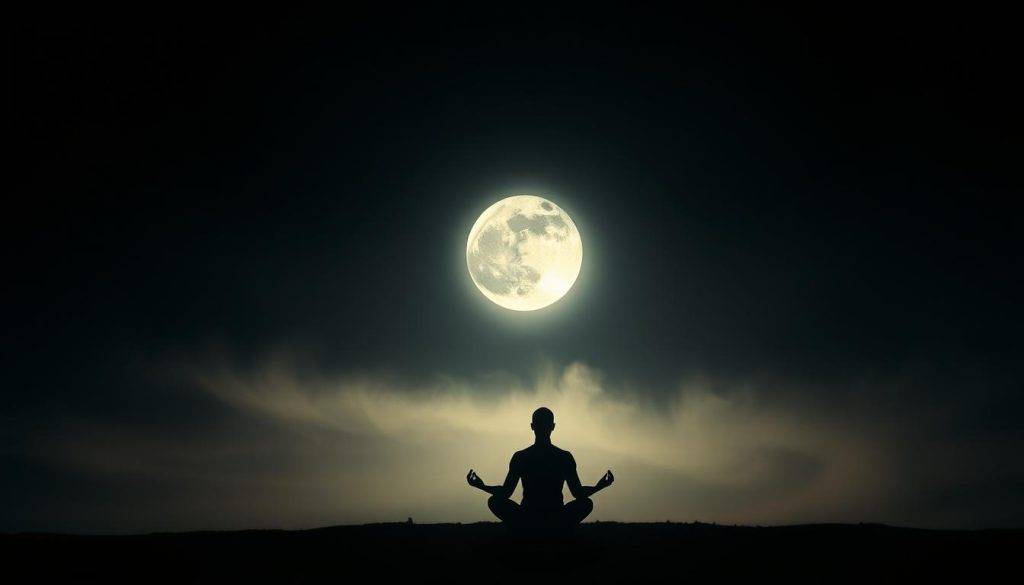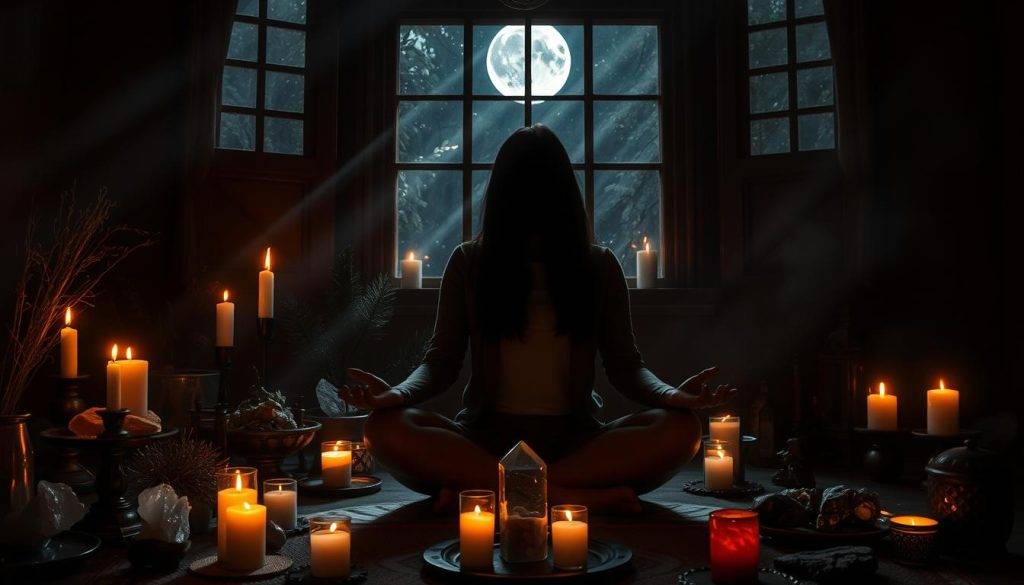“Until you make the unconscious conscious, it will direct your life—and you will call it fate.” Carl Jung’s words echo the transformative power of confronting what lies hidden—a theme mirrored in the dance of celestial bodies during rare cosmic alignments.
Astronomical events have long inspired introspection. When Earth’s orbit momentarily obscures the moon, it creates more than a visual spectacle. These moments invite reflection—a chance to explore the interplay of light and darkness both above and within.
Just as the moon temporarily retreats from view, personal growth often requires facing suppressed emotions or traits. This practice, rooted in psychological principles, encourages individuals to reclaim fragmented parts of themselves. By doing so, they cultivate resilience and authenticity.
The convergence of science and spirituality offers unique opportunities for transformation. Understanding orbital mechanics enhances appreciation for these events, while introspective practices provide tools for meaningful change. This guide bridges cosmic wonder with actionable steps—empowering you to embrace growth during these potent moments.
Key Takeaways
- Celestial alignments create opportunities for psychological exploration
- Light-dark contrasts symbolize internal balance and self-discovery
- Integrating overlooked emotions fosters personal authenticity
- Scientific understanding deepens spiritual experiences
- Transformative practices thrive at intersections of knowledge and intuition
Understanding the Spiritual and Scientific Aspects of Eclipses
Mysteries of the cosmos have long bridged the gap between empirical study and inner reflection. Whether a solar eclipse obscures daylight or a full moon dims in Earth’s penumbra, these events awaken both analytical minds and imaginative spirits.

The Astronomical Mechanics Behind Eclipses
Three celestial players create these phenomena: the sun, Earth, and moon. A solar eclipse occurs when the moon blocks sunlight, casting a shadow on Earth. Depending on alignment, it can be:
- Total (complete coverage)
- Partial (partial blockage)
- Annular (moon too distant for full coverage)
Lunar variations depend on Earth’s position. A full moon entering Earth’s umbra becomes a total lunar eclipse, while partial or penumbral versions occur with lighter shadows.
Historical and Cultural Significance
Ancient Mesopotamians tracked eclipses as omens. Norse myths described sky wolves chasing celestial lights. For many Indigenous people, these events symbolized renewal or divine messages.
Today, scientists predict alignments with precision—yet the awe remains. Modern people gather to witness these moments, blending data-driven curiosity with timeless wonder. As one astronomer noted, “Eclipses remind us that science explains the ‘how,’ but the ‘why’ still stirs the soul.”
What Is Shadow Work and Why It Matters
The human psyche holds uncharted territories—aspects of identity often buried beneath layers of conscious thought. Exploring these hidden dimensions forms the foundation of shadow work, a practice rooted in Carl Jung’s theory of the unconscious mind. By confronting suppressed emotions and traits, individuals uncover pathways to deeper self-awareness and alignment.

Defining the Shadow Self
Jung described the shadow self as the repository of traits, desires, and memories deemed socially unacceptable. These elements don’t vanish—they influence behaviors, relationships, and decision-making. For instance, someone who suppresses anger might struggle with passive-aggressive tendencies. Acknowledging these fragments reduces their unconscious control.
The Role of Shadow Work in Personal Growth
Engaging with one’s shadow isn’t about judgment—it’s integration. Methods like journaling prompt honest self-dialogue, while creative practices like poetry or art externalize inner conflicts. Over time, this fosters emotional resilience and authentic expression. Studies show that individuals who embrace their full identity report higher life satisfaction and healthier connections.
Consider how avoiding vulnerability strains relationships or how unprocessed fears limit career choices. Shadow work reverses these patterns by replacing avoidance with curiosity. As Jung observed, “What you resist persists.” By welcoming the full spectrum of their humanity, people cultivate balance—a harmony reflected in both private reflection and outward action.
The Phenomenon of Lunar Eclipses: Science and Symbolism
When celestial bodies align, they cast more than shadows—they reveal patterns. Earth’s orbit occasionally positions itself between the sun and moon, creating three distinct celestial variations. Each type offers unique visual and metaphorical insights into light’s dance with obscurity.

Understanding Celestial Variations
Three primary alignments shape these events:
| Type | Light Coverage | Visibility | Symbolic Meaning |
|---|---|---|---|
| Penumbral | Outer shadow dims brightness | Subtle, often unnoticed | Gentle inner shifts |
| Partial | Partial umbral shadow | Visible dark “bite” | Transition phases |
| Total | Full umbral coverage | Red hue (“blood moon”) | Profound transformation |
Eclipse seasons—occurring every six months—allow multiple alignments within weeks. These periods magnify opportunities for observation and reflection. Ancient Mayans viewed them as portals for spiritual renewal, while modern astronomers track their precise cycles.
The dark side of these events mirrors unexplored personal traits. Just as sunlight reveals the moon’s crimson glow during totality, confronting emotional darkness can illuminate hidden strengths. Cultures from Babylon to Tibet interpreted these moments as invitations to rewrite narratives—both cosmic and personal.
Lunar Eclipse Shadow Work: A Practical Guide
Celestial rhythms offer more than visual drama—they create portals for personal evolution. When natural light fades temporarily, it mirrors moments when inner truths surface. This alignment provides a unique way to engage with hidden aspects of your psyche through intentional practices.

The following table outlines a structured approach to self-discovery during these potent periods:
| Step | Focus | Action |
|---|---|---|
| 1. Set Intentions | Clarity | Write three questions about patterns you want to understand |
| 2. Create Space | Energy Flow | Light candles to symbolize bringing light to inner shadows |
| 3. Reflect & Release | Emotional Balance | Journal about recurring feelings, then safely burn the page |
| 4. Integrate Insights | Growth | Design a daily affirmation based on discoveries |
Many report heightened emotional receptivity during these phases. This occurs as gravitational forces amplify introspection—a time when suppressed memories or desires often emerge. Intuitive practices like breathwork or guided visualization help channel this energy constructively.
Consider how dimmed celestial light parallels moments of vulnerability. Just as the moon regains brightness, confronting personal shadows leads to renewed self-awareness. One practitioner shares: “I used meditation to visualize releasing old fears—it felt like shedding weight I’d carried for years.”
To maintain momentum, track progress in a dedicated notebook. Note how specific feelings shift across weeks or months. Over time, this way of working with cosmic cycles becomes a trusted tool for authentic living.
Simple Techniques for Eclipse-Inspired Shadow Work
Exploring inner depths requires practical methods that align with cosmic rhythms. Two accessible practices—journaling and mirror exercises—serve as powerful tools to navigate self-discovery during celestial alignments. These approaches help individuals uncover hidden patterns while fostering emotional clarity.

Journaling for Self-Discovery
Writing creates a safe space to surface repressed emotions. Begin by asking: “What recurring thought feels unresolved?” Document responses without filtering. Over time, patterns emerge—a tool for identifying unconscious triggers. Studies show daily journaling reduces stress and improves mental health by externalizing inner dialogues.
Engaging in Mirror Exercises
Stand before a mirror and observe reactions to these statements: “I accept my…” or “I release my…”. Notice discomfort—it often points to the shadow side. Repeat affirmations like “Every part of me deserves compassion” to soften resistance. This practice helps integrate fragmented aspects of identity.
If intense emotions arise, consider seeking professional help. Therapists provide strategies to process discoveries safely. Prioritizing mental health ensures these techniques empower rather than overwhelm. As one counselor notes: “Acknowledging your shadow side isn’t weakness—it’s wisdom in action.”
Solar vs Lunar Eclipses: Choosing the Right Moment for Introspection
Celestial darkness carries different messages depending on its origin. Solar and moon-related events each illuminate distinct aspects of self-discovery—like flashlights revealing hidden corners of a room. Knowing which cosmic alignment suits your current needs amplifies the power of inner exploration.

Symbolic Meanings of Solar Eclipses
When sunlight briefly vanishes, it often signals fresh starts. Cultures worldwide interpret this phenomenon as a sign to release outdated habits. Jung noted, “Every beginning requires darkness—a fertile void where potential takes root.” For those seeking clarity on career shifts or creative projects, these moments spotlight hidden opportunities. They’re ideal for eclipse shadow work focused on external goals.
Emotional Insights During Moon-Related Events
In contrast, Earth’s shadow on the moon unveils buried feelings. This phase magnifies relationship patterns or unspoken fears—things often overlooked in daily life. One therapist compares it to “emotional X-rays revealing fractures needing care.” If you’re processing grief or rebuilding trust, this time shadow offers gentle momentum for healing.
Your readiness determines which event longer serves growth. Immediate action thrives under solar energy, while gradual change benefits from lunar reflection. Track how specific things surface during each phase in a journal. Over time shadow, you’ll recognize which celestial rhythm aligns with your inner compass—proving that patience often longer serves profound transformation.
Rituals, Ceremonies, and Creative Practices for Healing
Intentional practices transform ordinary moments into gateways for healing. During an eclipse, crafting personal rituals allows individuals to harmonize with cosmic rhythms while honoring their inner landscape. Taking time to design these ceremonies creates a bridge between external events and internal growth.

Creating Sacred Spaces with Rituals
Begin by selecting elements that mirror natural cycles. Candles symbolize light piercing darkness—much like the eclipse shadow reveals hidden truths. Crystals such as labradorite or obsidian connect practitioners to the earth shadow, grounding energy during reflection.
Herbs like lavender or sage cleanse spaces, inviting clarity. Arrange these items in a quiet corner—a visual reminder of balance. “Rituals thrive when infused with love,” notes a mindfulness coach. This approach softens resistance to challenging emotions.
Consider this evening practice:
- Take time to sit quietly after lighting the candle
- Hold a clear quartz while setting healing intentions
- Write release statements on bay leaves, then burn them safely
Taking time to repeat such rituals builds emotional resilience. They transform fleeting celestial events into lasting tools for self-discovery. By weaving love into each step, participants cultivate compassion for both their bright and obscured qualities.
Harnessing Eclipse Energy for Transformation and Growth

Celestial alignments act as cosmic amplifiers—moments when intention-setting carries heightened potency. When an eclipse happens, the temporary dimming of light creates a symbolic bridge between observable reality and inner potential. This convergence offers a unique opportunity to channel celestial patterns into personal evolution.
Setting Intentions and Integrating Lessons
Begin by identifying patterns your inner side has concealed. What habits or beliefs no longer serve your growth? Write them down during the eclipse window—studies show written goals increase achievement rates by 42%. Pair each release with an affirmation, like “I welcome clarity as I release fear.”
Acknowledging your neglected side isn’t about fixing flaws—it’s reclaiming fragmented energy. Therapists recommend visualizing these traits as puzzle pieces. As you integrate them, a sense of wholeness emerges. One participant shared: “I finally embraced my assertive side—it transformed my career negotiations.”
Post-eclipse reflection turns insights into action. Review journal entries from the event. Which themes repeat? Create a three-step plan:
- Name one behavior to change
- Design a daily micro-habit supporting this shift
- Share progress with a trusted ally
As eclipses happen cyclically, track how your sense of wholeness deepens over time. Those practicing eclipse rituals report 68% higher consistency in personal goals. Remember: lasting change thrives when spiritual awareness meets practical steps. By honoring both your radiant and shadow side, you cultivate the resilience to navigate life’s contrasts—and ultimately, achieve wholeness.
Conclusion
Celestial patterns mirror the rhythms of personal evolution—each phase offering a chance to grow. Penumbral lunar phases, with their subtle shifts in light, reflect how inner transformation often begins in quiet moments of reflection. These cosmic events remind us that confronting hidden aspects of ourselves requires both curiosity and courage.
Embracing self-discovery practices isn’t a single act but a lifelong journey. Scientific understanding of orbital mechanics enriches spiritual practices, creating a balanced approach to growth. When emotions feel overwhelming, leaning on a support group or therapist can provide grounding—turning challenges into stepping stones.
Apply the techniques shared here during future celestial alignments. Notice how penumbral lunar cycles mirror your progress—gentle yet persistent. Trust that transformation, like planetary movements, follows natural rhythms. With each intentional step, you’ll find greater harmony between your brightest qualities and those waiting in the wings.
Remember: You’re never alone in this process. A support group or mentor can offer fresh perspectives when the path feels unclear. As the skies teach us through their cycles, your capacity for renewal grows stronger with every phase.
FAQ
How do celestial events enhance self-reflection practices?
Celestial alignments create energetic shifts that amplify introspection. The Earth’s alignment with the sun and moon during these moments illuminates hidden emotions, making it easier to confront patterns that no longer serve growth. Many find this timing ideal for releasing old habits or limiting beliefs.
What’s the difference between solar and lunar energies for inner work?
Solar phases often symbolize new beginnings—ideal for setting intentions. Lunar phases, particularly during full illumination, emphasize emotional clarity and releasing what’s unresolved. Both offer unique opportunities, but lunar energy tends to deepen emotional insights due to its connection to subconscious patterns.
Can these practices negatively impact mental health?
When approached mindfully, self-reflection strengthens emotional resilience. However, confronting deeply buried feelings may feel overwhelming initially. Tools like grounding exercises or support groups help maintain balance. If intense emotions arise, consider seeking guidance from licensed therapists or trusted mentors.
Why are penumbral phases significant in personal transformation?
Penumbral phases occur when celestial bodies partially align, casting softer shadows. Symbolically, this represents the gray areas of human experience—ideal for exploring nuanced emotions or situations where clarity feels elusive. It encourages acceptance of complexity while fostering patience in the healing process.
How can someone start integrating cosmic cycles into daily routines?
Begin by tracking moon phases through apps like Time Nomad or Moon Phase Calendar. Pair this with weekly journaling to note emotional shifts. Over time, patterns emerge, revealing how cosmic rhythms influence mood and decision-making. Small rituals, like meditation during key phases, deepen this connection organically.
Are there tools to make shadow exploration more accessible?
Yes. Apps like Insight Timer offer guided meditations, while journals like The Shadow Work Workbook provide structured prompts. Creative practices—art therapy or movement—also help bypass mental resistance. The key is choosing methods that feel intuitive rather than forced.
How does astronomy explain the symbolism behind Earth’s shadow?
Scientifically, shadows during celestial events occur due to light obstruction. Symbolically, this mirrors how unconscious thoughts block self-awareness. Just as the moon temporarily darkens but regains light, humans can acknowledge hidden aspects without losing their core essence—a metaphor for resilience in personal growth.




























































